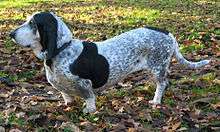Basset Bleu de Gascogne
 A Basset Bleu de Gascogne | |||||||||||||||||||||
| Other names |
Blue Gascony Basset Bleus de Gascogne | ||||||||||||||||||||
|---|---|---|---|---|---|---|---|---|---|---|---|---|---|---|---|---|---|---|---|---|---|
| Origin | France | ||||||||||||||||||||
| |||||||||||||||||||||
| |||||||||||||||||||||
| Domestic dog (Canis lupus familiaris) | |||||||||||||||||||||

The Basset Bleu de Gascogne (French pronunciation: [bɑsɛ blø də ɡasˈkɔɲ]), also known as the Blue Gascony Basset, is a long-backed, short legged breed of dog of the hound type. The breed originated in the Middle Ages, descended from the Grand Bleu de Gascogne. It nearly became extinct around the early 19th century; its salvation was attributed to one Alain Bourbon. A French native breed, it is rare outside of its homeland. It is recognized internationally by the Fédération Cynologique Internationale, in the UK by The Kennel Club, and by the United Kennel Club in the United States. The "bleu" of its name is a reference to its coat which has a ticked appearance.
Appearance
The color of their coat is predominantly white, ticked so as to give a bluish appearance, with brown spots and tan markings above the eyes and on the ears.[1] They are a smooth-coated breed.[2] Height at the withers is usually between 34 and 42 centimetres (13 and 17 in) although the Kennel Club standard specifies 30–38 centimetres (12–15 in).[1][3] Their general appearance is usually not too heavy, and they weigh between 16 and 18 kilograms (35 and 40 lb). They have dark brown eyes and low-set ears that can reach at least the end of their muzzle.[1] Because of their working nature as a hunting hound, effects of this work such as scars, nicks, notches on the ears and so on are not considered a fault in the show ring.[4]
History
The Basset Bleu de Gascogne descended directly from the old breed of Grand Bleu de Gascogne.[4] They have been recorded in paintings from the 14th century in Gascony, southwest France. The exact origin of the breed is debated, one theory is that it is a cross of the Grand Bleu with the Saintongeois Basset, another theory is that the Basset Bleu is a natural mutation of the Grand combined with selective breeding for shorter legs in order to slow down the breed.[5] It is thought that Gaston III of Foix-Béarn kept a pack of these dogs to hunt wild boar and wolves.[6] He is known as the writer of the Livre de chasse, considered the classic treatise on medieval hunting.[7]
Prior to the French Revolution, hunting was reserved for the nobility who generally hunted on horseback. Following the French Revolution, hunting was opened up to the common people who would hunt on foot and found following a large hunting dog difficult. From this the slower, shorter legged Basset Bleu de Gascogne may have been created.[5]
During the early 19th century the breed nearly became extinct with a declining popularity in hunting. However, the breed was saved and revived by the work of Alain Bourbon.[5]
Today, the Basset Bleu is one of six types of Basset Hound recognised by the Fédération Cynologique Internationale.[8]
Recognition and categorisation
The Kennel Club of the UK recognizes the Basset Bleu De Gascogne in the imported breed register and in the Hound Group.[3] The United Kennel Club recognised the breed in 1991,[5] and both they and the Fédération Cynologique Internationale (FCI) list the Basset Bleu De Gascogne in the Scenthound Group.[4][9] The breed is also known as the Blue Gascony Basset in the FCI.[9] The Basset Bleu De Gascogne is not recognized by the American Kennel Club or the Canadian Kennel Club. In addition to the major registries, the Basset Bleu De Gascogne is also recognized by many minor registries and specialty registries, including as a rare breed under the American Rare Breed Association which uses the FCI standard.[10]
See also
References
- 1 2 3 Cunliffe, Juliette (1999). "The Hound Group". The Encyclopedia of Dog Breeds. Parragon. p. 208. ISBN 978-0-7525-8018-0.
- ↑ Hutchinson, Robert (2005-02-07). "The Low-down on Dachshunds and Bassets". For The Love Of Dachshunds. BrownTrout Publishers. p. 36. ISBN 978-1-56313-903-1. Retrieved 2010-01-29.
- 1 2 "Basset Bleu De Gascogne Breed Standard". The Kennel Club. Retrieved 2016-04-28.
- 1 2 3 "Basset Bleu de Gascogne (Revised January 1, 2009)". United Kennel Club. 2009-01-01. Archived from the original on 2009-10-15. Retrieved 2010-01-29.
- 1 2 3 4 "Basset Bleu de Gascogne Information". Sarah's Dogs. Retrieved 2010-01-30.
- ↑ "Le Basset Bleu de Gascogne" (in French). Elevage Amateur Du Mas Gauthier. Archived from the original on 2011-07-20. Retrieved 2010-01-30.
- ↑ Tuchman, Barbara (1987-07-12). A Distant Mirror: The Calamitous 14th Century (Reissue paperback ed.). Ballantine Books. ISBN 978-0-345-34957-6.
- ↑ Fogle, Bruce (2002). Dogalog. Dorling Kindersley. p. 48. ISBN 978-0-7894-8394-2.
- 1 2 "Blue Gascony Basset". Fédération Cynologique Internationale. 1996-01-24. Archived from the original on 2010-05-25. Retrieved 2010-01-29.
- ↑ "Blue Gascony Basset". American Rare Breed Association. Archived from the original on 2010-06-13. Retrieved 2010-01-29.
External links
| Wikimedia Commons has media related to Basset bleu de Gascogne. |
- Excellent video of a pack of Basset Bleu de Gascognes hunting YouTube
- Basset Bleu de Gascogne at DMOZ